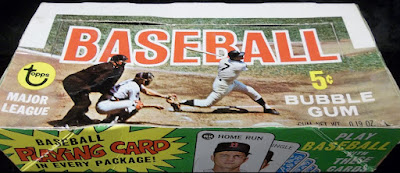I was nearing the end anyway, having only three other 1968 cards that I planned to post (Ramon Hernandez, Greg Goossen, and Jim Campanis), but I don't think anyone will miss them.
This 1968 box photo reminds me of when I was collecting cards by-the-pack back in 1967-69. I would band the cards for each team together, and have an "NL box" and an "AL box". (Checklists and leaders would fit in wherever there was room.)
Our local corner store would let us take empty boxes home if we bought the last pack(s) in it.
In 1968, I remember having so many duplicates that a 3rd box held 3 stacks of doubles. Then in a 4th box were my stacks of triples, 4's, and 5's. I actually had a 5th box for 6's, etc, (which as I recall was mostly just Bud Harrelson cards).
Not all boxes had the playing cards pictured on the front panel, but I don't remember which series they were inserted in (I want to say 2nd thru 4th).
If you haven't seen it already, please scroll down to the end of the sidebar to read comments about the set that I wrote, and posted on Zistle some years ago.






















.jpg)

.jpg)








.jpg)






.jpg)


